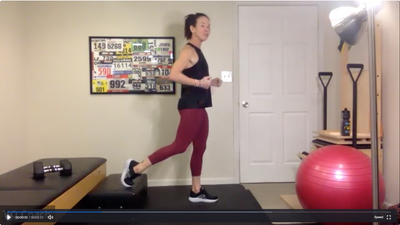The How-To's and Why’s to Strengthen Your Knees and Add Longevity To Your Running
Scene: Sitting around the fire pit with pals. Your pals just found out you are a runner.
Top most likely heard comments:
Oh yikes! Running is the worst on your knees!
I would run too, but I have bad knees.
If you don’t have knee problems now, you’re gonna!
You love running, or maybe you’re trying to love running and you hear things like this, what are you supposed to think, and what should you do? Is what your pals are saying true?
The truth is running has long had a bad rap when it comes to knee injuries. But running on its own isn’t as bad on the knees as people once thought. There was a recent study in the journal of Arthritis Care and Research that showed that runners who logged the most mileage actually reported less knee pain than their counterparts! Now, the knee DOES take the brunt of the impact with every step in a run. When it comes to injuries, knees do account for 28% in runners. A large proportion of these result in undertaking too much mileage, frequency, or intensity too soon. Stresses related to significant terrain change, like moving from all trail running to running on concrete, or vice versa. All of these factors can overstress the tissues around the knees. That is why strengthening the muscles surrounding the knee is essential to running durability, stability and preventing injury!
When we dissect the running gait we see that the hamstrings contract when flexing the knee, and when the knee is extended the quadriceps engage. These muscles are important to target when it comes to preventing and rehabbing injuries. And bonus- having strong hamstrings and quadriceps, combined with a strength training routine that includes core work will also positively impact your running performance! What's not to like?
The objective of the exercises shown and explained later in this article is to help address possible weakness and imbalances in the hamstrings and quadriceps. When these weaknesses and imbalances exist, they can lead to issues like runners knee (or pain under the knee cap. This accounts for apx. 25% of running related injuries according to research from Orthopedic Reviews), patellar tendinitis, or pain below your knee cap and at the top of your shin. Iliotibial band syndrome- pain on the side of your knee is also common.
Combining the exercises shown below, as well as a whole body strength training program that you might already be doing from PN, Pilates, or your own program are an excellent way to not only strengthen all your muscles, but to better be able to withstand the repetitive muscle contractions of running and absorb the forces that come with every foot strike. All you need is a towel, a resistance band, and possibly some weights. Lace up your running shoes and let's get ready to add some longevity to your running!
Suggestions:
If you are currently experiencing running pain, take a day or two off of running, and try these moves instead.
Modify your existing strength routine to include these exercises
Start with body weight, but as you get more confident with your form, add weights.
Integrate 2x's a week
Watch the videos below at least twice to get a good sense of the form, and to hear the explanation of WHY that move is beneficial.
Reverse Towel Lunge: 1-2 sets of 8-10 reps on each side
Single-Leg Deadlift: 1-2 sets of 8-10 reps on each side
Lateral Banded Walk: 2-3 sets of 10 steps on each side
Lateral Lunge: 1-2 sets of 10 reps on each side
Step Up: 3 sets of 8 reps on each side
Split Squat: 3 rounds of 8 reps on each side
The goal of integrating these exercises are to help strengthen and support the muscles that will help support positive knee health, as well as improve the functional range of motion of the joint. As always, when integrating something new into your exercise routine, error on the conservative side and keep form and safe technique at the top of your mind.
And hopefully next time you are with your friends around the ol’ fire pit, you can confidently tell them all about the next running goal you are getting after since you have developed to an even stronger and more durable athlete!

